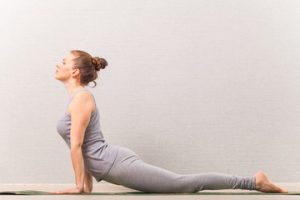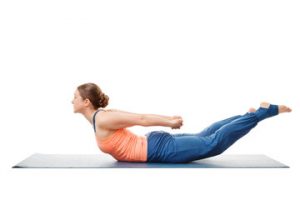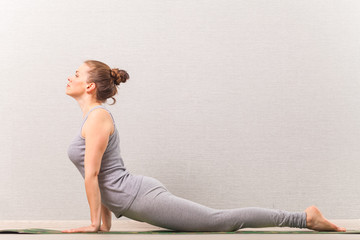The sciatica nerve begins from the lower back region, and it runs deep throughout the hips, thighs and the sides of legs. The problem of Sciatica is mainly caused by stress, compression, injury, irritation in the sciatica nerve, or the lower vertebrae. In addition, tight, overused, and injured muscles can also cause sciatica pain.
This pain is pretty sharp and produces a burning sensation that majorly shoots and spreads down the leg. The people who suffer from it feel numb, inflammated, and tingling sensation in the region. This pain causes discomfort and extremely serious pain.
In case the reason of sciatica pain is a herniated or a bulging disk, a yoga session that can develop from gentle poses to the fundamental asanas like standing poses or downward poses can help in align, lengthen and strengthen the lower back. A herniated disk does not need surgery always because a practice like yoga can help in reducing the problems. Regardless, it is very important to consult a doctor about how severe the herniation is as there are times when surgery is needed.
Let us now take a look at some of the yoga asanas that can help in preventing, soothing, and healthy sciatica pain.
1. CHILD POSE
Practicing this yoga asana is a great way to tap into your body and relax it. It helps in lengthening and strengthening the spine, enhancing the flexibility and openness in the region of hips, thighs, and the lower back. To aid this yoga asana with more support, you can place a cushion so that your thighs, chest, and forehead feel supported. Begin on your hands and knees while bringing your knees together. Now sink your hips back onto your heels. Extending your arms in front of you or allowing them to rest in a calm position, let your torso relax completely so that you fall heavy on the thighs. Stay focuses on deepening your breath so that you can relax all the areas of tightness. Stay in this pose for five minutes.
2. DOWNWARD FACING DOG
This yoga pose is a forward bend that can help you in bringing your body into alignment, relieving the pain and the tightness. It helps in promoting the strength in your body while assisting in correcting the imbalance. You can begin practicing this pose by starting on your hands and knees in a way that your hands are pressed as you lift your hips in the direction of ceiling. No drop your head in the downward direction so that your ears are in alignment with your upper arm and your chin is faced in the direction of your chest. Bend your knees so that they tilt in the forward direction of your pelvis. You can move your body through any variation that feels appropriate. Stay in this posture for one minute.
3. HALF MOON POSE
This yoga pose helps in balancing, strengthening, and stretching the body. It also helps in increasing flexibility, reducing stress, and stretching the spine. When you start doing this pose, start by supporting your body against a wall by placing a block under your hand. Resume the standing pose while keeping your right foot in front of you. Now bend your knees deep so that your body weight is balanced on your right foot. Now bring your left hand in the direction of your hip while sliding your left foot forward some inches while you reach for your right hand in the direction of the floor in front and to the right of the right foot. Lift your leg in a way that is in a parallel direction to the floor while pressing it out through the left heel. Rotate your torso and your hips open while you gaze in the forward direction. In order to go deeper, lift your head in the upward direction facing the ceiling while turning your gaze in the upward direction. Stay in this pose for at least one minute. Release your body be bending your right leg and lowering the left leg in the direction of the floor. Repeat the pose on the opposite side.
4. COBRA POSE

This yoga posture helps in strengthening and stretching the spine while promoting circulation and flexibility. Begin by being straight on your stomach in a way that your hands are placed under the shoulders. Squeeze your elbows into your body. Inhale by lifting your head, chest, and your shoulders. Keep your body in a bend so that your chest and elbows are open. Engage your thighs, lower back, and abdominal muscles. Stay in this position for half a minute and release and repeat.
5. LOCUST POSE

This yoga posture helps in strengthening the spine, glutes, and the thighs. It balances the core and the lower back while promoting the circulation and flexibility in the hips. Start by being straight on your stomach while keeping your fingers intertwined at the base of your spine. You can now lift your chest, your head and your arms as high as possible while bringing your arms up and away from your body. You can go deeper by raising your legs. Make sure that you engage your glutes, lower back, and the abdominal area by holding the yoga posture for at least 30 seconds. Release the yoga posture and return to the beginning by letting your body relax for some breaths as you move your body gently from one side to another. Repeat this posture for one or two times.
6. KNEES TO CHEST POSE
This yoga pose is very effective for reducing tightness in the lower back, hips, and glutes. If you want to take this slowly and feel the pose in a less intense way, then start with one leg at one time. Start by laying straight on your back and draw your knees in the direction of your chest. Draw your ankles and knees together so that you can reach your hands around the back of your thighs or around the shins. In case your hands reach, twine your fingers or take hold of the opposite elbows. Deepen this stretch, lift your head and tuck your chin in the direction of your chest. Stay in this position for one minute.
7. RECLINED PIGEON POSE
Practicing the pigeon pose on your back will help in supporting your lower back while putting lesser pressure on your hips. This pose helps in stretching the glutes and the hips for the piriformis muscle. Stay straight on your back with your knees being bent and the heels in the direction of the hips. Bend the right knee while bringing the ankle to the bottom of the left thigh. Stay in this position in case you feel a profound stretch. In order to go deeper, lift your left foot while drawing your left knee in the direction of your chest. Twine your fingers to hold behind the left thigh and the shin. Stay in this position for one minute and repeat on the opposite side.
8. BRIDGE POSE
This yoga pose helps in stretching the spine and reducing the pain and tension that is accumulated in the spine. It produces a gently stimulating effect on the body while boosting the blood circulation. In addition, it also works the legs, the core and the glutes. Begin by laying straight on the back with the knees being bent and the heels in the direction of your hips. Bring your arms alongside the body while facing your palms in the downward direction. Lift your spine from the floor and raise your hips as high as you can. Place a block in between your knees and thighs to stay aligned and slowly lower your body in the downward direction again. Repeat this yoga posture at least ten times for best results. Relax your body in the starting position and hold it back up for one minute.
CONCLUSION:
In case you have sciatica pain, the yoga poses that are mentioned above will be very helpful in feeling better. You can start practicing these poses with ease while ensuring maximum safety. Also, if it is possible, join a course of yoga teacher training India or yoga teacher training in Rishikesh so that you can get the best professional advice on these poses at least once a month to ensure that you are on the right track. In case the pain persists for more than a month, then make it a point to consult a doctor.
ADDITIONAL READ:
- How Exercise Can Help You Recover From Addiction
- How Yoga Can Improve Your Skin And Complexion
- 10 Essential Benefits Of Hot Yoga To Your Body
- 5 Ways Yoga Helps You Lose Weight








